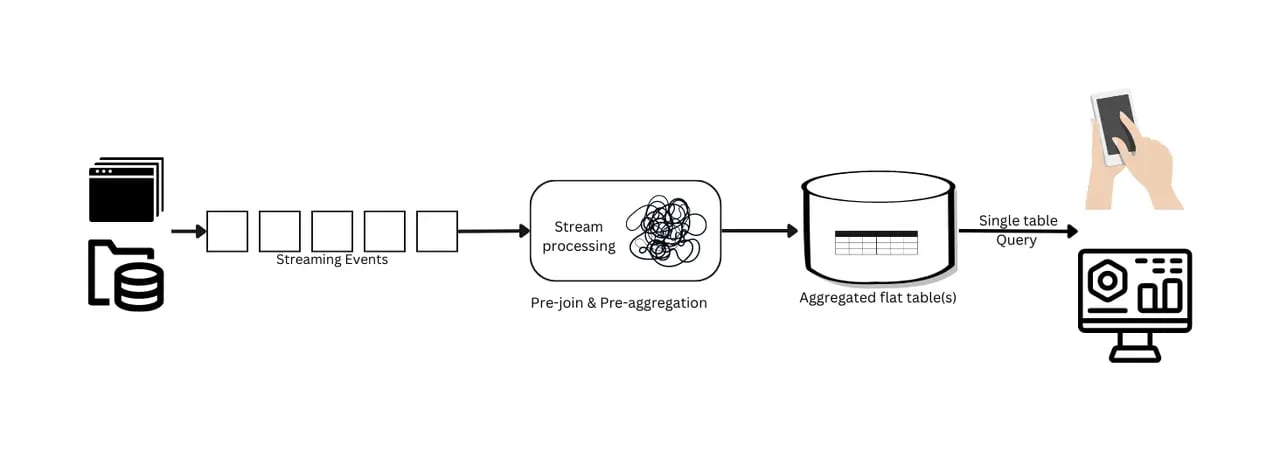
Join StarRocks Community on Slack
Connect on SlackIn today's rapidly evolving business landscape, data has become the lifeblood of modern enterprises. Real-time analytics has emerged as a critical component of data platforms across industries, with users seeking OLAP database solutions that can refresh their real-time dashboards, monitoring systems, and other applications in a matter of seconds while scaling data size to petabytes and beyond.
This technology has become a game-changer for modern enterprises as it enables them to respond to changing market conditions, customer demands, and industry trends in seconds. In this blog post, we will delve into the importance of real-time analytics, discuss the challenges faced in its implementation, and explore how StarRocks' innovative approach is revolutionizing the field.
Why Real-Time Analytics is Important: Instant data-driven decision-making (DDDM)
In a fast-paced business environment, companies must stay ahead of the curve by responding quickly to market changes and customer demands. Real-time analytics empowers businesses with the ability to make informed decisions based on up-to-date data, allowing them to capitalize on opportunities, address emerging threats, and stay ahead of competitors. This technology can help companies improve customer satisfaction, streamline operations, and optimize revenue streams. Below are some specific scenarios where real-time analytics can add significant value to businesses.
Personalization and recommendation
Real-time analytics can be used for personalization and recommendation to create unique and tailored experiences for customers across different channels. By using data from customers’ purchase history, browsing behavior, preferences, and feedback, retailers can offer relevant and timely suggestions of products and services that match their needs and wants. This is helpful for retailers to increase customer loyalty, satisfaction, conversion rates, and revenue.
Real-time system monitoring
Efficient operations management is essential for business success. Real-time analytics enables companies to monitor critical operations, identify potential bottlenecks, and allocate resources effectively. This proactive approach helps minimize downtime, streamline workflows, and ultimately drive cost savings.
Real-time anomaly detection
Unresolved issues can lead to significant financial and reputational losses for businesses. Real-time analytics allows companies to identify and address problems as they occur, mitigating risks, and protecting the company's bottom line and brand image.
Real-time Dashboarding
Real-time analytics is critical for dashboarding solutions, allowing businesses to monitor and track key performance indicators (KPIs) in real time. With real-time dashboarding, enterprises can see how their business is performing at any given moment, enabling them to make quick and informed decisions. This technology can also help identify issues or opportunities as they arise, enabling businesses to take corrective action quickly.
Fraud Detection
Fraud detection is another area where real-time analytics can add significant value. With the ability to process large amounts of data in real time, businesses can identify and prevent fraud in real time. This technology can help reduce losses and improve customer confidence by ensuring that fraudulent activities are detected and addressed in real time.
Supply Chain Management
Real-time analytics can also play a crucial role in supply chain management. By analyzing data in real time, companies can optimize their supply chain, reduce inventory costs, and improve delivery times. Real-time analytics can help businesses identify bottlenecks in the supply chain, enabling them to take corrective action quickly.
The Challenges of Real-Time Analytics
While real-time analytics has many benefits, there are also several challenges associated with this technology.
A complex technology stack
Building and managing a real-time analytics pipeline can be a daunting task due to the intricate technology stack involved. From data collection and preprocessing to storage and analysis, each stage of the pipeline requires specialized tools and expertise, making the process time-consuming and resource-intensive.
Stream processing tools in particular play a crucial role in the real-time pipeline as they preprocess the data before it is analyzed.
In a real-time analytics pipeline, stream processing tools ensure that:
-
The data is accurate and of high quality.
-
Necessary data transformation is performed, so the data is positioned to serve the purpose of downstream analysis or applications.

This makes stream processing tools a must with existing real-time ETL solutions. Although powerful, these tools are difficult to maintain and use due to their reliance on coding besides writing SQL scripts. As a result, their use in the pipeline contributes to increased complexity and expenses, which leads to companies abandoning real-time analytics altogether.
Denormalization

Denormalization is another challenge associated with real-time analytics. The end-to-end pipeline of data to insight consists of the sum of data freshness and the latency of the query. In nature, data is relational. Existing solutions lack support for multi-table queries, forcing users to perform denormalization in preprocessing to bypass multi-table JOINs. This adds complexity to the pipeline, is not flexible for business change, and is expensive and ineffective.
The status quo for real-time data updates
Another significant challenge of real-time analytics is how existing solutions deal with real-time data change. Merge on read (MOR) is a widely adopted (ClickHouse, Iceberg, etc.) update approach in which changes to data are made to a separate copy of the data, and the original data is not updated until it is merged with the new copy at a later time.

MOR: Merge versions required at query execution
This approach works ok for data freshness in the minutes but fails when in real-time analytics with data freshness in the seconds, as the merge operation can have a significant impact on query performance. This not only makes the query slow, but unpredictable and unstable, leading to uncertainty and frustration for users.
StarRocks: The Modern Approach to Real-Time Analytics
Recognizing these limitations in the real-time analytics space, the StarRocks project was born. To address the challenges, StarRocks developed several innovative solutions that simplified the preprocessing pipeline and made real-time data updates possible without compromising on query performance. This includes:
-
Real-time pre-aggregation and partial updates.
-
The primary key table enables real-time updates.
-
Integration with data lakes to unify historical and real-time data analytics.
Learn more about these powerful capabilities in our deep dive on StarRocks’ real-time analytics features article. If you’re a more hands-on learner, however, then you can get started with StarRocks for free by downloading it here and joining our Slack community here.
If you’d like to see StarRocks in action in minutes without having to waste time with setup, we recommend taking a look at CelerData Cloud which offers a free monthlong trial (as well as a free developer tier).

